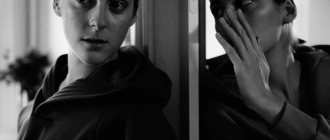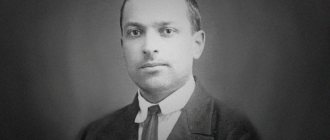Before moving on to the concepts and other scientific heritage of Lev Semenovich Vygotsky, it is worth saying a few words about him. His biography is not just interesting, it answers the question of how so many talents could be combined in one person, and how the scientist managed to achieve impressive success in various fields of science. Having lived only 37 years, Vygotsky left behind a huge scientific legacy: about three hundred books, lectures, articles, monographs on developmental psychology, defectology, art history and other fields of knowledge.
Lev Vygotsky: biography
Lev Semenovich Vygotsky was born in 1896 in the family of a businessman and a teacher, received a good education at home, which allowed him to pass exams for 5 grades and immediately enter the 6th grade of the gymnasium. During his student years, he managed to study at the medical and law faculties of Moscow University, and, in the end, made a choice in favor of the historical and philosophical faculty of Shanyavsky University.
His scientific interests were extremely multifaceted, and his teaching experience was very diverse. At various times, he gave lectures at vocational schools, a pedagogical college, at retraining courses for preschool teachers, and even at the conservatory.
The peak of Lev Vygotsky's scientific activity occurred in the 20s and early 30s of the twentieth century, but many of his researches are still relevant. His works have gone through many reprints and are still published to this day. In general, Vygotsky’s scientific heritage can be grouped into three main areas in which he achieved the most impressive results that are relevant and in demand to this day.
Vygotsky's main concepts:
- Cultural-historical concept and doctrine of higher psychological processes.
- Aesthetic art concept.
- Pedagogical concept.
It is interesting that even in his youth, Vygotsky changed one letter of his last name in order, in modern marketing language, to “detach” from the biography and successes of his cousin David Vygodsky. As time has shown, he succeeded to the fullest. After his death, the popularity of the scientist’s works became so great that many contemporaries called this phenomenon nothing more than the “cult of Vygotsky.”
Influence on the development of science
In world psychology, Vygotsky’s theory of the cultural and historical development of personality gained popularity in the 70s, when the scientist’s books began to be published in the West. Many works have appeared devoted to the understanding and development of his ideas.
American and European psychologists use Vygotsky's findings to develop methods for learning foreign languages and even researching modern computer technologies. In the context of cultural-historical theory, the possibilities of new forms of learning are considered: distance learning and electronic learning. Scientists D. Parisi and M. Mirolli proposed using the achievements of the Soviet psychologist to give robots more “human” features.
In Russia, Vygotsky’s theories were developed and reinterpreted by his students and followers. Among them are outstanding scientists P. Galperin, A. Leontiev, V. Davydov, A. Luria, L. Bozhovich, A. Zaporozhets, D. Elkonin.
In 2007, Cambridge University Press published a major study of the works of L. S. Vygotsky. Scientists from ten countries, including Russia, took part in its creation.
Cultural-historical concept and doctrine of higher psychological processes
The essence of Vygotsky’s cultural-historical concept is that the scientist considers it necessary to fundamentally distinguish between lower and higher psychological functions that directly influence human behavior. Vygotsky emphasized that, we quote, “consciousness determines life, but it itself arises from life.”
The scientist identified two plans of human behavior: the so-called “natural” or “natural”, predetermined by the biological component and not regulated by the will of man, and the so-called “cultural”, “socio-historical”, completely controlled by man. Vygotsky classified all aspects of behavior that a person is able to regulate as higher psychological processes, and those that a person cannot consciously influence, respectively, as lower psychological functions.
According to the situation in the 20-30s of the last century, this approach was a real breakthrough, since most scientists either idealized psychological functions as such, considering them to be fully conscious, or reduced them to a chain of biological and physiological reactions. Moreover, Vygotsky was, perhaps, the first who undertook to describe and systematize different aspects of similar psychological reactions.
Thus, within the framework of the cultural-historical concept, it is worth highlighting Vygotsky’s theory of attention. According to his theory, attention can be both involuntary, that is, a lower mental function, and conscious, that is, related to higher psychological functions. Involuntary attention prevails in the very first years of a child’s life. Accordingly, voluntary, that is, conscious attention, is already a characteristic of a more mature personality.
Thus, Vygotsky derives the following characteristics of psychological functions, according to which they can be classified as higher: sociality, arbitrariness, indirectness, systematicity. Such a classification, even if it is not flawless and the only correct one, nevertheless significantly simplifies the analysis and systematization of many observed phenomena.
Laws of age development
L. S. Vygodsky formulated several general provisions in the psychology of child development:
- Age-related development has a complex organization, its own rhythm, which changes at different periods of life;
- Development is a sequence of qualitative changes;
- The psyche develops unevenly, each side has its own period of change;
- Higher mental functions are collective forms of behavior and only then become individual functions of a person.
Aesthetic art concept
The methodology of Vygotsky’s aesthetic concept is in many ways similar to the already discussed cultural-historical concept. The scientist focused on two closely interrelated components of art. On the one hand, art influences life and the perception of life, on the other, it itself is largely predetermined by life and the perception of life.
In order to understand and understand the essence of a particular work of art, Vygotsky proposed disassembling its structure. The work had to highlight two key elements: form and material. Material, according to Vygotsky’s concept, should be considered what the work consists of: letters and words, if it is a literary work, words and sounds, if it is a theatrical production. In turn, form refers to one or another configuration of the material: poetry, prose, and so on.
Further, in order to make his conclusions more clear, Vygotsky proposed considering a work of art as a kind of anthropomorphic subject with its own anatomy and physiology. Structure is anatomy, and the interaction of structural elements is physiology. In relation to a literary work, this means that you first need to separate the plot and the plot (form and material), and therefore study their interaction.
According to Vygotsky, the secret of a successful literary work lies in the conflict between plot and fable, and the form must prevail over the material. This was a fundamentally new view of art, since before Vygotsky it was believed that plot and plot should cooperate harmoniously. However, Vygotsky saw this problem quite differently. Here it would be appropriate to note that Vygotsky was not only a great scientist, but also an avid theatergoer: he attended all the premieres in Moscow theaters when he studied and worked in Moscow, and in other cities where the fate of a scientist took him.
According to contemporaries, he was personally acquainted with Meyerhold, Stanislavsky, Eisenstein, Aikhenvald, and Mandelstam. He began writing his first theater reviews while still a student, and as his graduation thesis he presented a two-hundred-page work devoted to Shakespeare's play Hamlet. The key work that most fully reveals the essence of the aesthetic concept is considered to be Lev Vygotsky’s “Psychology of Art,” which was presented and defended as a dissertation in 1925.
Psychology of pedagogy
Most of Lev Semenovich Vygotsky’s works are devoted to the study of the psychological patterns of human development that arise in the process of upbringing and training. The term “pedology” is also used to denote this field of knowledge.
Education in psychology refers to the development of human abilities, the transfer of skills and knowledge. Education means working with personality and behavior. This is the area of feelings and relationships between people. Educational psychology has a close connection with sociology and physiology.
Pedagogical concept
And, perhaps, the most significant scientific legacy left by Vygotsky is his work in the field of child psychology. One might even say that the very fact of isolating child psychology into a separate science is largely the personal merit of Lev Vygotsky.
Thus, he explored the relationships between learning and development, thinking and speech, creativity and imagination, social environment and mental retardation. He deduced the basic principles of raising deaf-mute and blind children, children with signs of mental retardation, and also proposed his own classification in defectology.
Main developmental defects (according to Vygotsky):
- Defects of the perceptive organs (blindness, deafness, deafblindness).
- Defects in parts of the response apparatus, lack of working parts (cripples).
- Defects of the central nervous system (dementia).
The significance of the classification proposed by Vygotsky is extremely great, since the type of compensation and the development of the compensatory mechanism in children in the future directly depend on the type of defect. All these nuances are carefully considered in Vygotsky’s works and are presented in the form of specific recommendations and pedagogical techniques for working with children with developmental defects. Note that the availability of applied and methodological materials increases the value of innovation in education.
These recommendations are used in specialized educational institutions and boarding schools, and also become particularly relevant in connection with the development of inclusive education, that is, the joint education of children with regular and special educational needs in regular secondary schools. Vygotsky’s works are also useful for parents who want to understand the pedagogical and psychological problems of raising children.
It is interesting that, while studying the development of both normotypical children and children with developmental defects, Vygotsky found common patterns in working with both categories. As it turned out, the learning and development of normotypical and deviant children are subject to general principles.
Basic principles of training and development:
- Learning is not the same as development.
- Training must be ahead of development.
- Learning should take place in the “zone of proximal development.”
Thus, Vygotsky introduced the concept of “Zone of Proximal Development” into child psychology. In a nutshell, this is something that the child is already able to realize and understand, but cannot yet do completely independently and needs the help of an adult. For example, a child understands the need to tie shoelaces, but cannot tie them himself; a child knows numbers, but does not yet know how to add and subtract them. If at this moment adults come to the rescue and show how to tie shoelaces and tell them what addition and subtraction are, then very soon the child will be able to cope with these tasks on his own.
It is significant that the principle of learning in the “zone of proximal development” should also be applied to children with developmental defects. Otherwise, if training panders to the current level and physical condition of the child, then he risks remaining at the same level, or developing at a very slow pace. These are the main concepts of Vygotsky, which remain relevant to the situation today. Note that this is not a complete list of areas in which Lev Vygotsky conducted scientific research.
Those who would like to give their children more and raise them as harmoniously developed individuals would be interested in the scientist’s works devoted to sensitive periods of development, that is, periods of maximum opportunities for the most effective formation of any knowledge, skill, or sensory perception. Knowing the characteristics of different sensitive periods, you can choose the optimal time to start teaching children music, drawing, and mathematics.
Those who are frightened by a child’s habit of talking to himself should read Vygotsky’s book “Thinking and Speech” to understand how necessary this stage is for the formation of internal, and then competent, written speech. Therefore, read, learn more and be sure to apply the acquired knowledge in practice!
We also recommend reading:
- Storytelling
- Paul Feyerabend's Epistemological Anarchism: Promise or Delusion?
- Zone of proximal development
- Lomonosov: unique achievements of a “universal” person
- Agnosticism as freedom of knowledge
- How to raise a child correctly?
- A Brief History of Psychology: From Antiquity to the Present Day
- Humanistic theories of personality: what to take from history to modern times
- Human attention: what it is and how it works
- Wundt's method of studying psychology
- Personality criteria
Key words: 1LLL, 1Cognitive science
Levels
In the theory of developmental development, Vygotsky identified two important levels. Let's look at them:
- Zone of current development. This is the child’s level of available preparedness, those tasks that he is able to complete without help from adults.
- Zone of proximal development. It includes tasks that the child cannot solve on his own, only with the help of an adult. However, through interaction with other people, the child gains the necessary experience and subsequently becomes able to perform the same actions independently.
According to Vygotsky, learning should always go ahead of development. It should be based on the age stages that have already been passed and focus on the functions that have not yet been fully formed, the potential capabilities of the child.
The most important factor in a child’s development is cooperation with an adult. Moreover, learning occurs not only at school, but also in everyday life and in the family.
Work with children
Perhaps it was sincere kindness, the ability to deeply feel other people and treat their shortcomings with condescension that led Vygotsky to defectology. He always maintained that limited abilities in one thing are not a death sentence for a child. The flexible child's psyche actively seeks opportunities for successful socialization. Dumbness, deafness, blindness are just physical limitations. And the child’s consciousness instinctively tries to overcome them. The main responsibility of doctors and teachers is to help the child, push him and support him, and also provide alternative opportunities for communication and obtaining information.
Unified Labor School
It was the prototype of a democratic school based on a creative, dynamic, collaborative pedagogy. It was ahead of its time, imperfect, and made mistakes, but it was still successful.
Vygotsky’s ideas were implemented by teachers Blonsky, Wenzel, Shatsky and others.
The pedological theory was tested at the school:
· psychological and pedological diagnostic rooms operated;
· constant medical and psychological monitoring was carried out;
· classes were created according to the principle of the child’s pedological age.
This school existed until 1936, when the Soviet authorities began attacking it. The school was repurposed as a regular one.
The very idea of pedology was distorted, and it fell into oblivion. Pedology and the idea of a labor school received a second life in the 90s. with the collapse of the USSR. A unified labor school in the modern sense is a democratic school, very appropriate in today's education.






